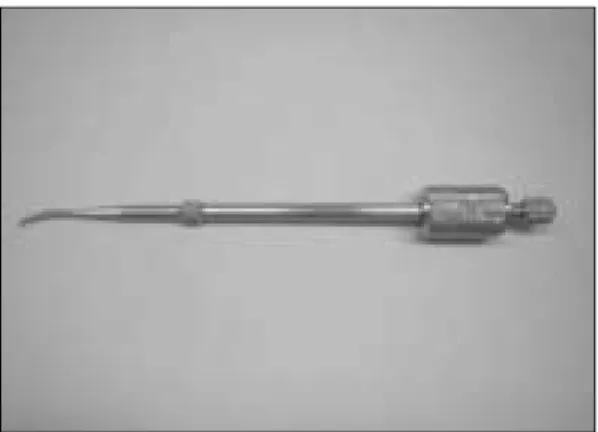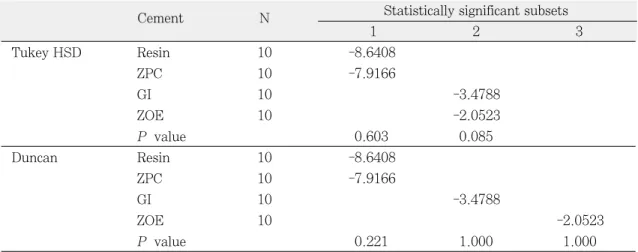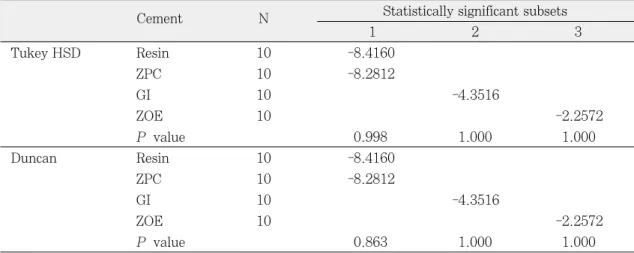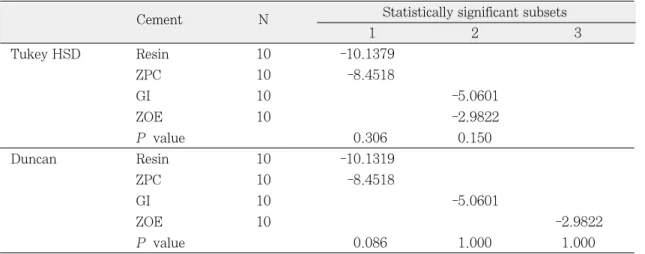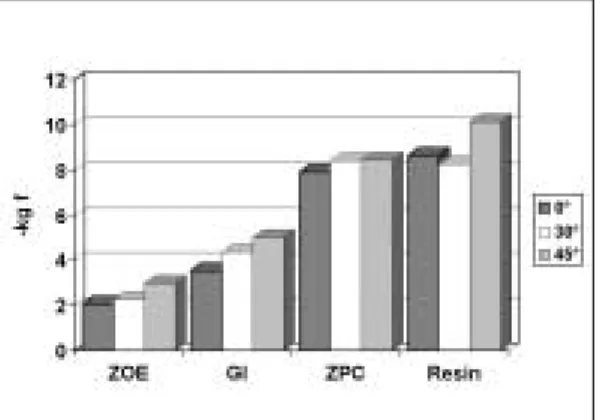Ⅰ. 서 론
1985년 Bra¨nemark에 의해 치과계에 골 유착성 임플랜트가 처음 도입된 이래로1-3)상실된 치아의 수 복에 임플랜트의 사용이 늘면서, 초기에는 주로 임 플랜트 fixture에 대한 연구가 이루어졌으나, 최근에 는 상부 보철물의 형태 및 문제점에4-8) 대한 관심이 늘어나고 있다.
일반적으로 임플랜트 보철물은 형태에 따라서 screw type과 cementation type으로 분류할 수 있으 며, screw type은 보철물의 제거가 용이하고, 과부하 시 나사 풀림을 야기하여 임플랜트를 보호하는 역할 을 하며, 다양한 상부 보철물의 선택이 가능한 것 이 외에도 3-4mm가 넘는 치은 연하에서 잉여 시멘트 제거의 필요성이 없는 등의 장점이 있다.
그러나 지대주 나사의 파절 및 풀림, 금 나사의 파 절 및 풀림, 교합 조정의 용이성, 조작의 단순함, 적 합도, 경제성, 심미적인 이유로 최근에는 screw type 의 보철물 보다는 cementation type의 보철물이 많이 쓰이고 있으나, 이는 보철물을 영구 접착한 후 지대 주 나사가 풀려서 보철물이 흔들리거나, 치주 질환 등의 원인으로 보철물을 제거하고 청결시켜야 할 필요가 있을 때, 보철물을 잘라내어 제거한 다음 새 로 제작을 해야만 하는 단점이 있다.9-13)이에 저자는 합착 후에도 보철물을 손상 없이 제거할 수 있도록 하기 위하여, 지대주와 보철물상에 일정한 형태를
부여하고 이에 맞도록 제작된 금속 쐐기(metal wedge)를 이용하여 보철물의 분리가 가능하도록 하 였다. 즉, wedge 작용을 이용하여 설면에서 지대주 와 보철물 사이의 분리를 fixture에 손상을 주지 않는 작은 힘으로 가능하도록 고안하였으며, crown ejec- tor의 끝을 변형시켜 그러한 작용이 나타나도록 제작 하였다.
Ⅱ. 연구 재료 및 방법
길이 10mm, 지름 4mm의 cementation type implant abutment (NEOBIOTECH implant abut- ment, regular, 3。taper, Ti grade III, machined sur- face, Hwasung, Kyunggi-do) 30개를 abutment chamfer margin에서 2.0 mm 상방에 지름 2.0mm hole을 지대주의 장축에 직각으로 형성하였으며, duralay resin과 inlay wax로 금관의 납형을 제작한 후, 납형의 설측에 지름 2.0 mm hole을 지대주 내면 의 hole과 1 mm 정도 overlapping 되도록 cervical 쪽으로 형성하되(Fig. 1) 금관의 장축에 수직이 되는 평면을 기준으로 0。, 30。, 45。각도로 각기 10개씩 제작하였으며(Fig. 2), 통법에 따라 금 합금 (Stabilor H, Type III Gold-Palladium-Silver alloy, Au 56%, Ag 32%, Pd 4%, Degussa Dental Inc., Duesseldorf, Germany)으로 주조하였다. 또한 wedge effect를 내기 위해 지름 1 mm round taper, 대한치과보철학회지:Vol. 42, No. 5, 2004
손상 없이 영구 접착 보철물을 제거할 수 있는 cementation type 임플랜트 지대주 개발에 관한 연구
서울대학교 치과대학 치과보철학교실 최진호∙이재봉
※ 본 연구는 서울대학교 신임교수 연구 정착금 지원사업 연구비에 의하여 지원되었음.
60。point end가 되도록 metal wedge (Rexillium V, Ni-Cr alloy, Ni 73%, Cr 14%, Pentron U.S.A.) (Fig.
3, 4)를 제작하였다.
각 보철물을 지대주에 맞도록 조절한 후 4 종류의 시멘트(Table I)를 이용하여 지압으로 seating하고 시 멘트 경화 후 10분 후에 수조(37℃)에 넣어 48시간
Table I. The cements used for luting the crown to the implant abutment
Cement Manufacturer
Zinc Oxide & Eugenol Cement Temp-bond, Kerr
Glass Ionomer Cement GC Fuji I, GC
Zinc Phosphate Cement Elite Cement 100, GC
Resin Cement Panavia F, Kuraray Medical INC.
Fig. 1. The diagram of the holes for the retrieval. Fig. 2. The holes located at the crowns were directed 0。, 30。, 45。to the horizontal plane.
2.0mm 1.0mm
0。 30。 45。
Fig. 3. The diagram of the metal wedge. Fig. 4. The metal wedge was made of Ni-Cr alloy for the experiment.
10.0mm 1.0
mm 1.0 mm
3。
60。
동안 보관하였다. Metal wedge를 지대주와 금관에 형성한 hole에 삽입시키고 Universal testing ma- chine(Instron 4465, Instron Korea) (Fig. 5, 6)을 이용하여 압력을 가하였으며, 지대주와 금관의(Fig.
7) 분리 여부 및 분리되는 순간의 최대 압력(kg)을 측정하였다(crosshead speed ; 1mm/min). 또한 crown ejector tip을 변형하여(Fig. 8) wedge 형태로
만든 후 ejector의 push 작용에 의해 tip의 끝에서 발 생되는 압력의 최대치를 저울 위에서 측정하였다 (CAS 전기식 지시 저울, KSC1313).
이번 실험의 분석에는 ANOVA test(p<0.05) 및 Duncan’s post hoc test, Tukey’s post hoc test를 사용하여 통계처리 하였다.
Fig. 7. The cemented gold crowns to the implant abutments.
Fig. 8. The modified crown ejector with wedge-shaped tip.
Fig. 5. Instron 4465. Fig. 6. Load was applied to the lingual hole of the gold crown through the metal wedge to separate the crown from the implant abutment.
Ⅲ. 연구 결과 1. 0。시편
Table II-3. One-way ANOVA test
Sum of squares df Mean square F value P value
Between groups 316.745 3 105.582 62.37 < .0001
Within group 60.941 36 1.693
Total 377.687 39
Table II-4. Tukey’s and Duncan’s post hoc test
Cement N Statistically significant subsets
1 2 3
Tukey HSD Resin 10 -8.6408
ZPC 10 -7.9166
GI 10 -3.4788
ZOE 10 -2.0523
P value 0.603 0.085
Duncan Resin 10 -8.6408
ZPC 10 -7.9166
GI 10 -3.4788
ZOE 10 -2.0523
P value 0.221 1.000 1.000
Table II-1. The value of retrieval in the group of 0�hole (kg)
Cement ZOE GI ZPC Resin
Mean -2.052 -3.478 -7.916 -8.640
SD 0.594 0.996 1.430 1.838
Table II-2. Descriptive statistics
Cement N Mean SD 95% confidence interval Min Max
ZOE 10 -2.0523 0.5940 (-2.4772, -1.6274) -3.21 -1.09
GI 10 -3.4788 0.9965 (-4.1916, -2.7660) -5.71 -2.25
ZPC 10 -7.9166 1.4307 (-8.9401, -6.8931) -10.84 -6.37
Resin 10 -8.6408 1.8381 (-9.9557, -7.3259) -10.89 -5.57
SUM 40 -5.5221 3.1120 (-6.5174, -4.5269) -10.89 -1.09
2. 30。시편
Table III-3. One-way ANOVA test
Sum of squares df Mean square F value P value
Between groups 276.463 3 92.154 30.600 < .0001
Within group 108.415 36 3.012
Total 384.878 39
Table III-4. Tukey’s and Duncan’s post hoc test
Cement N Statistically significant subsets
1 2 3
Tukey HSD Resin 10 -8.4160
ZPC 10 -8.2812
GI 10 -4.3516
ZOE 10 -2.2572
P value 0.998 1.000 1.000
Duncan Resin 10 -8.4160
ZPC 10 -8.2812
GI 10 -4.3516
ZOE 10 -2.2572
P value 0.863 1.000 1.000
Table III-1. The value of retrieval in the group of 30�hole (kg)
Cement ZOE GI ZPC Resin
Mean -2.257 -4.351 -8.416 -8.281
SD 0.635 0.995 2.264 2.35
Table III-2. Descriptive statistics
Cement N Mean SD 95% confidence interval Min Max
ZOE 10 -2.2572 0.6351 ( -2.7115, -1.8029) -3.39 -1.33
GI 10 -4.3516 0.9956 ( -5.0638, -3.6394) -6.20 -2.63
ZPC 10 -8.4160 2.2642 (-10.0357, -6.7963) -12.15 -5.39
Resin 10 -8.2812 2.3506 ( -9.9627, -6.5997) -12.39 -4.40
SUM 40 -5.8265 3.1414 ( -6.8312, -4.8218) -12.39 -1.33
3. 45。시편
Table IV-3. One-way ANOVA test
Sum of squares df Mean square F value P value
Between groups 313.922 3 104.641 22.938 < .0001
Within group 164.228 36 4.562
Total 478.150 39
Table IV-4. Tukey’s and Duncan’s post hoc test
Cement N Statistically significant subsets
1 2 3
Tukey HSD Resin 10 -10.1379
ZPC 10 -8.4518
GI 10 -5.0601
ZOE 10 -2.9822
P value 0.306 0.150
Duncan Resin 10 -10.1319
ZPC 10 -8.4518
GI 10 -5.0601
ZOE 10 -2.9822
P value 0.086 1.000 1.000
Table IV-1. The value of retrieval in the group of 45�hole (kg)
Cement ZOE GI ZPC Resin
Mean -2.982 -5.060 -8.451 -10.137
SD 0.981 1.204 3.045 2.561
Table IV-2. Descriptive statistics
Cement N Mean SD 95% confidence interval Min Max
ZOE 10 -2.9822 0.9813 ( -3.6842, -2.2802) -4.46 -1.22
GI 10 -5.0601 1.2041 ( -5.9214, -4.1988) -7.24 -3.30
ZPC 10 -8.4518 3.0454 (-10.6303, -6.2733) -13.69 -5.12
Resin 10 -10.1379 2.5614 (-11.9702, -8.3056) -14.38 -6.73 SUM 40 -6.6580 3.5015 ( -7.7778, -5.5382) -14.38 -1.22
Ⅳ. 총괄 및 고안
치과 임플랜트의 보편화가 이루어지면서 임플랜 트 보철물의 유지 관리에 대한 필요성도 부각되고 있다. 일반적으로 보철물 장착 후 매 5년 마다 나사 를 조여주어야 하며,14)모든 환자는 첫 해에는 3개월 마다 소환하여 검사를 해야 하고, 매년 한 번씩은 모 든 보철물을 해체하여 소독해야 하며 외과의와 보철 의 모두 임플랜트 시술을 받은 환자 관리에 책임이 있다고 하였다.15)심지어 ADA의 진료 code 06080은 임플랜트 보철물을 제거하여 청소하고 그 아래 고정 장치를 청결하게 하는 술식을 말하며 대부분의 보험 회사는 1년에 2번은 인정한다고 한다.16)실례로 1년 동안 기능한 임플랜트 시술을 받은 환자의 정기적 재검에 소요되는 시간은 치과의사에 의한 것이 48 분, 위생사에 의한 것이 50분으로 그 노동력은
$ 121에 달하며 재료는 평균 $ 119, 간접비용 $ 77, 모든 비용은 $ 317이어서 일반 총의치의 $ 94 보다
$ 223가 더 든다고 한다.17)
이러한 이유로 진료 시간을 단축하기 위해 신속한 retrievability 확보가 중요하게 되었으나 screw type 에서의 지대주 나사의 파절 및 풀림, 금 나사의 파절 및 풀림에 비해 cementation type은 교합 조정의 용 이성, 조작의 단순함, 적합도, 경제성, 심미적인 장점 을 갖고 있지만 지대주로부터 금관을 제거해야 할 경우 금관 절단에 의한 제거 외에는 거의 불가능하
다.9-13) 그럼에도 불구하고 최근에는 cementation
type implant abutment의 사용이 증가하고 있어 ce- mentation type implant abutment system의 re- trievability에 대한 문제가 대두되었다. Retriev- ability를 확보하기 위해 임시 접착제로 합착하였을 경우, 자주 탈락되기 때문에 환자의 신뢰를 잃을 수 있어 영구 접착제를 이용하여 합착해야 하는 경우가 많으며 이 경우 나사 풀림이나 보철물의 청결시 제 거에 어려움을 겪게 된다.
이러한 cementation type 보철물의 단점을 극복하 고자 지대주와 금관의 설측 면에 일정한 크기의 hole 을 같은 위치에 형성하여 ultrasonic device나 다른 장 치를 이용하여 보철물을 제거하는 법,18)cylindrical guide hole을 지대주에 형성하고 보철물에는 access hole을 형성하여 removing driver의 끝으로 돌려서 shear force를 유발함으로써 보철물을 제거하는 법,19) abutment access chamber와 abutment retaining screw를 보철물의 제거에 용이하게 위치시켜 지대주 나사가 풀렸을 때 쉽게 접근할 수 있게 하는 방법20) 등이 연구되어 있다.
본 연구에서 4 종류의 시멘트로 합착된 시편을 metal wedge를 이용하여 실험한 결과, 모든 지대주 와 보철물 간의 분리가 가능하였으며, 이는 지대주 와 보철물 hole내로의 metal wedge의 압력이 두 성 분 사이에 shear force를 유발시켜 분리가 가능하게 된 것으로 생각되어 진다. 이는 임상에서 crown 4. Modified crown ejector에 의한 압력 측정
Fig. 9. The value of retrieval for the various cements.
Table V. The value of separating force obtained by crown ejector (kg)
1 2 3 4 5 6 7 8 9 10 Mean SD
7.571 7.027 6.870 7.388 8.245 7.683 6.757 6.553 7.763 6.878 7.273 0.511
ejector tip을 같은 모양으로 변형하여 압력을 가하면 구강 내에서도 지대주와 보철물의 분리가 가능하다 는 것을 의미한다. 즉, crown ejector로 낼 수 있는 최 대 압력은 실험 결과 평균 7.273 kg이며 이는 위의 실험에서 나타난 ZOE 와 GI cement로 합착한 경우의 보철물을 제거할 때 필요한 압력 보다는 크며, ZPC 나 resin cement의 경우에서 보다는 작았다. 물론 같 은 시멘트라 하더라도 그 적용 방법에 따라 차이가 있겠지만 본 실험에서 사용된 시멘트 정도라면, 기 성의 crown ejector tip을 변형시켜 구강 내에서 힘을 가해 ZOE 와 GI로 합착된 보철물을 지대주로부터 분리시킬 수 있음을 의미한다. 만일 crown ejector의 추의 무게를 증가시키거나, 길이를 증가시켜서 좀 더 큰 힘을 낼 수 있게 변형시킨다면 ZPC 와 resin cement로 합착된 보철물도 제거할 수 있을 것이다.
보철물의 장축에 직각 즉, 수평면에서 0。의 각도 로 힘을 가했을 때 보다는 30。, 45。로 힘을 가했을 때가 분리시에 더 큰 압력을 필요로 하는데, 이는 30。, 45。로 힘을 가했을 때의 힘의 vector를 수평과 수직 방향으로 나누게 되면 수평 방향의 vector 양이 지대주의 장축에 직각(수평면에서 0。)으로 힘을 가 했을 때의 힘과 비슷한 수치가 나오게 된다. 예로서 ZOE cement로 합착한 금관의 분리시에 가해진 압력 을 보면 30。금관에서 -2.257 kg, 45。금관에서 -2.982 kg으로 각각 수평 방향의 vector를 계산하면 -1.954 kg, -2.108 kg으로 0。금관일 때의 -2.052 kg 과 비슷한 압력을 나타낸다. GI cement, ZPC, resin cement 의 경우에는 약간의 차이가 있지만, 보철물 을 지대주로부터 분리시키는 힘은 치관 장축에 직각 방향으로 작용하는 힘이며, 30。, 45。의 경우에는 수 직 방향의 힘이 임플랜트에 추가로 가해지게 되는 것이다. 따라서 가능한 한 수평 방향의 힘만을 가해 최소의 힘만으로 보철물을 분리하는 것이 좋겠으나, 실제 임상에서 구강 내 접근 시 crown ejector로 wedge effect를 내게 하는 경우 수평면에서 30。, 45。정도의 접근 방향이 일반적일 수 밖에 없다.
시멘트의 종류에 따라 임플랜트 보철물의 유지력 을 측정한 Rachel의 논문21)에서 보면, ITI 임플랜트 8。taper의 Ti abutment에서 합착제로 쓰인 시멘트 중에 resin cement, ZPC, GI , ZOE cement의 순서 로 높은 유지력을 나타냈으며, 이는 본 실험에서 시 멘트의 종류에 따른 분리에 소요된 압력과 같은 순
서를 나타냈다. 물론 30。시편에서는 ZPC가 resin ce- ment보다 약간 큰 수치를 나타냈으나 통계학적으로 유의성이 없었다(p=0.998). 본 실험 성적의 분석에 는 ANOVA test(p<0.05) 및 Tukey’s and Duncan’
s post hoc test를 하였으며, 각 시편별, 시멘트 종류 별 통계처리 결과 유의성에 차이를 보였지만, 전반 적으로 위의 순서대로 금관 제거에 필요한 압력의 크기를 나타냈다. Rachel의 연구21)에서 resin ce- ment의 유지력은 40kg 이상이었으며, 이는 본 실험 에서 resin으로 접착시킨 금관의 분리에 필요한 압력 의 약 4-5배 정도의 수치에 해당하는 것이었다. 물론 두 실험에서 여러 가지 실험 조건(지대주 경사, 표면 조도, 지대주 높이, 시멘트)등에서 차이가 있었지만, 본 실험에서처럼 metal wedge를 이용하여 shear force를 유발시키는 방법이 훨씬 적은 힘으로 보철물 을 분리시킬 수 있다는 결론을 얻었다.
본 실험에서는 동일한 임플랜트 지대주만을 사용 하였고, 지대주가 3。taper를 가지고 있으며, 수평으 로 serrated 되어 있어 분리시에 적지 않은 압력이 필 요하였다. 즉 지대주의 높이, 표면적, taper 정도, milling 각도, 표면 조도, 적용된 cement 종류 등에 따라 보철물 분리시에 가해야 하는 힘에 차이가 날 수 있으므로22-29)앞으로 이에 대한 세부적인 연구가 필요하다고 생각된다. 또한 앞서 언급했듯이 crown ejector의 변형을 통해 ZPC 나 resin cement로 합착 한 경우에도 보철물의 분리가 가능하도록 해야 할 것이며, crown ejector로 힘을 가했을 때 fixture에 가 해지는 유해한 측방력이 osseointegration에 미치는 영향에 대한 연구도 필요하다.
Ⅴ. 결 론
본 연구는 시멘트 접착성 임플랜트 지대주에 시멘 트로 접착시킨 금관의 retrievability를 연구하기 위하 여 길이 10mm, 지름 4mm의 cementation type im- plant abutment (NEOBIOTECH implant abut- ment, regular, 3。taper, Ti grade III, machined sur- face)와 각각의 금관에 retrievability 부여를 위한 hole을 형성한 후 4 종류의 시멘트를 이용하여 합착 하고 metal wedge를 이용한 분리 실험을 행하여 다 음과 같은 결론을 얻었다.
1. 모든 금관이 비교적 작은 힘으로 metal wedge에
의하여 지대주로부터 분리되었다.
2. Metal wedge의 적용 각도가 지대주의 장축에 수 직인 경우에 가장 작은 힘으로 분리가 가능하였 다.
3. 분리에 필요한 압력은 4 종류의 시멘트 중 resin cement, zinc phosphate cement, glass ionomer cement, zinc oxide & eugenol cement 순으로 resin cement의 경우가 가장 컸다.
4. Crown ejector의 push 작용에 의해 유발할 수 있 는 최대 압력은 ZOE 와 GI 시멘트로 합착한 보철 물의 분리에 필요한 압력보다는 크고, ZPC 와 resin 시멘트로 합착한 보철물의 분리에 필요한 압력보다는 작았다.
5. 본 실험과 같은 조건 하에서라면 임상적으로 구 강 내에서 변형된 crown ejector에 의해 ZOE 와 GI 시멘트로 합착 된 보철물은 모두 지대주로부 터 손상 없이 분리시킬 수 있다는 결론을 얻었다.
참고문헌
1. Zarb GA, Jansson T, Jemt T. Other prosthodontic applications. Quintessence Int 1985;283-292.
2. Jemt T. Modified single and short span restorations supported by osseointegrated fixtures in the partially edentulous jaws.
J Prosthet Dent 1986;55:243-246.
3. George H, Clayton GH. The effect of lut- ing agents on the retention and marginal adaptation of the ceraone implant system.
Int J Oral Maxillofac Implants 1997;12:
660-665.
4. Adell R, Lekholm U, Rocklier B. A 15-year study of osseointegrated implants in the treatment of the edentulous jaw. Int J Oral Surg 1981;10:387-416.
5. Zarb GA, Schmidt A. The longitudinal clinical effectiveness of osseointegrated dental implants : the Toronto study. Part II : the prosthetic results. J Prosthet Dent 1990;64:53-61.
6. Zarb GA, Schmidt A. The longitudinal
clinical effectiveness of osseointegrated dental implants : the Toronto study. Part III : problems and complications encoun- tered. J Prosthet Dent 1990;64:185-94.
7. Jemt T. Failures and complications in 391 consecutively inserted fixed prosthe- sis supported by Bra¨nemark implants in edentulous jaws : a study of treatment from the time of prosthesis placement and to the first annual check up. Int J Oral Maxillofac Implants 1991;6:270-6.
8. Preiskel HW, Tsolka P. Telescopic prosthesis for implants. Int J Oral Maxillofac Implants 1998;13:352-7.
9. Whinston C, David A. Cement-retained ver- sus screw-retained implant prosthesis : which is better? Int J Oral Maxillofac Implants 1999:14(1):137-141.
10. Kenneth S, Hebel KS, Reena C, Gajjar RC.
Cement-retained versus screw-retained implant restorations : Achieving optimal occlusion and esthetics in implant dentistry.
J Prosthet Dent 1997;77(1):28-35.
11. Guichet D, Caputo A. Passivity of fit and marginal opening in screw-or cement-re- tained implant fixed partial denture designs.
Int J Oral Maxillofac Implants 2000;15:
239-246.
12. Misch CE. Screw-retained versus cement- retained implant-supported prosthesis.
Practical Periodontics Aesthetic Dentistry 1995;7(9):15-8.
13. Misch CE. Principles for cement-retained fixed implant prosthodontics. Contemporary Implant Dentistry 1993;651-668.
14. Binnon PP, Sutter F. The role of screws in implant system. Int J Oral Maxillofac Implants 1994;9:48-63.
15. Wilson TG. Maintenance problems and pro- tocols. Int J Oral Maxillofac Implants 1994;75.
16. Tekavec, C Insurance. Dental Economics
1997;20.
17. Wijk P, Bouma J. The cost of dental im- plants as compared to that of conven- tional strategies. Int J Oral Maxillofac Implants 1998;13:546-553.
18. Fernando P. Alternative method for re- tention and removal of cement-retained im- plant prosthesis. J Prosthet Dent 2001;
86:2.
19. Okamoto M. Technique for removing a ce- mented superstructure from an implant abutment. J Prosthet Dent 2002;87:2.
20. John D. Simplified technique for retriev- ing cemented implant restoration. J Prosthet Dent 2002;88:3.
21. Rachel S. Retentiveness of dental ce- ments used with metallic implant com- ponents. Int J Oral Maxillofac Implants 2001;15:793-798.
22. Lee JB. The retrievability of cementa- tion type implant abutment by surface treat- ments and types of cements. J Korean Acad Prosthodont 1999;37:545-551.
23. Smith BGN. The effect of the surface
roughness of prepared dentin on the re- tention of castings. J Prosthet Dent 1970;
23:187-98.
24. Rosenstiel E. The taper of inlay and crown preparations, a contribution to dental terminology. British Dental Journal 1975;139(11):436-8.
25. David A. Effects of abutment size and lut- ing cement type on the uniaxial retention force of implant-supported crowns. J Prosthet Dent 2000;83:344-8.
26. Willey RL. Retention in the preparation of teeth for cast restorations. J Prosthet Dent 1976;35:526.
27. Kaufman EG, Coelho AB, Colin L. Factors influencing the retention of cemented gold casting. J Prosthet Dent 1961;11:487-502.
28. Gilboe DB, Teteruck WR. Fundamentals of extracoronal tooth preparation. Part I : Retention and resistance form. J Prosthet Dent 1974;32:651.
29. Kent D, Koka S, Froeschle M. Retention of cemented implant supported restorations.
J of Prosthodont 1997;6(3):193-6.
Reprint request to:
Jin-Ho Choi, D.D.S.
Dept. of Prosthodontics, College of Dentistry, Seoul National University 28-1, Yeongun-Dong, Chongno-Gu, Seoul, 110-749, Korea
cjh2050@lycos.co.kr
Purpose: This study was performed to investigate the retrievability of the cemented crown from the cementation type implant abutment.
Material and method: The cementation type implant abutments (NEOBIOTECH implant abutment regular, 3 degree taper, 10mm length, 4mm diameter, Ti grade III, machined surface, Hwasung, Kyunggi-do) and cemented crowns were divided into 3 groups, depending on their hole angles formed in the crowns for their retrievability. The abutments and crowns were luted with 4 kinds of cements and separation test using metal wedge was executed with Instron 4465 Universal Testing Machine and the maximum impact force of the modified crown ejector was measured.
Results and conclusion:
1. All of the cementation type implant abutments and cemented crowns were separated with relatively small force by metal wedge.
2. The retrieving force was minimum when the metal wedge was applied perpendicular to the axis of abutment.
3. The force for retrieving crowns from abutments was maximum in resin cement group, and reduced in orders of zinc phosphate cement, glass ionomer cement and zinc oxide eugenol cement.
4. The maximum force obtained by the crown ejector was higher than the retrieval force in ZOE and GI cement and lower than that in ZPC and resin cement.
5. If it has similar conditions clinically, the cemented crowns luted with 2 types of cements (ZOE, GI cement) can be safely retrieved from the cementation type implant abutments by the mod- ified crown ejector.
A STUDY ON THE COMPLETE RETRIEVAL SYSTEM OF THE CEMENTATION TYPE IMPLANT ABUTMENT
Jin-Ho Choi, D.D.S., Jai-Bong Lee, D.D.S., M.S.D., Ph.D.
Department of Prosthodontics, Graduate School, Seoul National University ABSTRACT
Key words : The cementation type implant abutment, Retrievability, Metal wedge, The modified crown ejector

